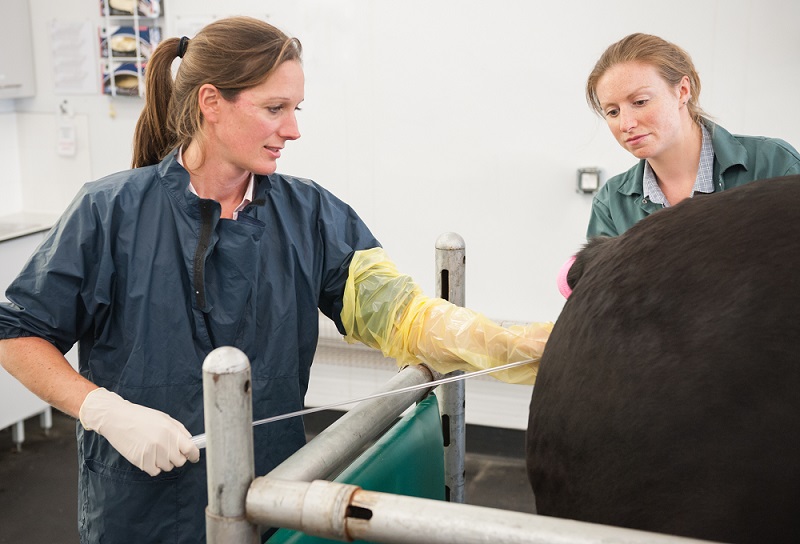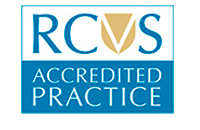24 hour contact: 01707 666297
Studwork and Artificial Insemination
If you are thinking of breeding with your mare or stallion, we offer the following range of services to help this process go smoothly with our experienced equine stud vets. If you would like to discuss the breeding process and our reproductive services with one of our stud vets, please ring the office on 01707 666297.

Care and Management of your Broodmare
We are here to offer advice if you would like to discuss the process of putting your mare in foal, and can offer support throughout, from pre-breeding checks to improving the chance of getting your mare in foal. We can also advise throughout the pregnancy, we will be on hand if there is a problem at foaling and will perform mare and new foal checks. The RVC offers hospitalisation with our team of expert medics and surgeons in the case of any problems with either the mare or foal throughout the breeding process.
Pre-breeding mare examinations:
This often involves:
- Ultrasound examination (a scan) of the mare’s uterus and ovaries.
- Vaginal and cervical examination using a speculum.
- Pre-breeding swabs for diseases including Contagious Equine Metritis (C.E.M.), a contagious venereal disease.
- Pre-breeding bloods for infectious diseases such as Equine Viral Arteritis (E.V.A.) and Equine Infectious Anaemia (E.I.A.).
- Possibly an endometrial swab to assess the uterine environment.
Pre-breeding stallion examinations:
- Pre-breeding swabs and bloods, similar to the mare protocol.
- Pre-purchase examinations to check semen quality and potential fertility of the stallion for the future.
Insemination
Once you have decided to put your mare in foal, then you need to look for the right stallion. Artificial insemination is now much more common than natural cover for sports horses, and most breeds other than Thoroughbreds (natural cover is still a requirement for the TB industry). This is because:
- It means that you can choose for a far wider range of stallions, including those abroad (or even deceased stallions if using frozen semen).
- It reduces the risk of injury to the stallion and the mare.
- The mare can be kept locally rather than travelling her long distances to stud.
Artificial insemination (A.I.) can be performed with fresh, chilled or frozen semen, and contraception rates are usually good. However, to achieve good contraception rates, the mare’s oestrus cycle needs to be monitored carefully to establish exactly when to inseminate her (as close to ovulation as possible) to achieve the best results. The mare will sometimes be given hormones to manipulate the cycle and ovulation time to give the best chance of success.
Considerations for use of fresh, chilled or frozen semen?
Fresh or chilled semen:
Ideally, the mare will be inseminated with fresh or chilled semen within 24 hours prior to ovulation (although many stallions will have semen which will survive for longer than this). This timing, achieved by regular ultrasound scanning of the mare’s uterus, achieves optimum conception rates. Good communication with the stallion owner/stud is imperative so:
- Check which days they can collect and send the semen (often dictated by the post or courier service).
- Ask the stallion owner if the stallion’s semen chills and travels well.
- Check if there are transport costs.
NB. Semen coming from abroad must be accompanied by the relevant health certification.
Frozen semen:
Frozen semen can be kept for years and is thawed immediately prior to insemination. It has a short life span and so careful monitoring of the mare’s cycle is required to time insemination as close to ovulation as possible (within six hours either side of ovulation) to maximise the chance of conception. This often requires several ultrasound examinations (up to every six hours) so it is most commonly done with the mares in our hospital.
Despite conception rates being lower for frozen semen than fresh/chilled semen, frozen semen does offer the following benefits:
- Using stallions from all over the world.
- Using deceased stallions with previously collected semen.
- Using stallions which are still out competing, and not retired to stud yet.
When looking for a stallion and purchasing frozen semen, we would advise the following:
- Buy from a reputable stud.
- Ask them about the semen quality and how well that particular stallion’s semen freezes and thaws. How good is the semen motility after thawing?
- Ask how many doses/straws of the semen are included in the price.
- Specialist transport of frozen semen is required, and the semen should arrive at our hospital in plenty of time prior to the insemination date. It will be stored in our liquid nitrogen tank. Ask about these transport costs.
- Semen from abroad must be accompanied by the correct health certification/paperwork.
Post Insemination:
After insemination, your mare will be re-scanned to check for ovulation and any post-breeding problems such as uterine inflammation or fluid. If problems are encountered, post-breeding treatment may be required (e.g. a uterine flush). Scanning for pregnancy (and specifically to check for twins) is then typically performed at day 14-16 post ovulation, and then again at day 28-30 to check for a heartbeat. A 45-day pregnancy scan is also usually performed to make sure everything appears to be progressing normally.
Mare Infertility Investigation
What happens if your mare does not get pregnant?
Unfortunately, getting every mare pregnant is not always plain sailing and this can be for a number of reasons:
- Mare fertility reduces with age, particularly in mares that have not been bred previously.
- The stallion is not very fertile (or is not very compatible with an individual mare) – the stallion can also be investigated if necessary.
- Infection or inflammation within the reproductive system.
The mare can be investigated to try to establish the problem and involves some or all of the following:
- A careful history of the mare will be taken.
- Ultrasound examination of the reproductive tract.
- Vaginal and cervical examination with a speculum.
- Uterine swabs and endometrial cytology/culture
- Uterine biopsy
- Endoscopy of the uterus
Foaling
Our team of experienced on-road vets offer an emergency service 24hrs a day, 365 days a year and will provide immediate veterinary assistance if your mare is having trouble at foaling.
Dystocia (the mare being unable to successfully deliver the foal naturally for some reason) is a serious and potentially life-threatening situation for both the mare and foal, and requires immediate veterinary intervention. This possibility should be considered by any owner thinking of breeding their mare. Sometimes, in these situations, the foal will be able to be delivered vaginally (i.e. normally) with an assisted/controlled technique, which may involve a general anaesthetic and then hoisting the mare’s hips up to be able to re-align the foal. However, there are times that the foal cannot be delivered via the vagina and a Caesarian section will be required. This requires the mare to be transported to our hospital where our experienced team of surgeons would perform a Caesarian section in one of our operating theatres. We also have a dedicated team of medicine specialists at our hospital if either your mare or foal requires hospitalisation at any point throughout pregnancy or after birth.

